One of the most desired, and often most misunderstood, articles in the vintage wardrobe are the trousers.
Today I’m going to delve a little bit into the basics of the transition of trousers from the 1930’s through the 1950s. It’s a quick overview so I’m not touching on everything, but it will give you a good starting point!
– A Beginning –
Women and trousers. It’s a love affair in modern times, but was it in the past? Well, no- actually. If you remember good ol’ Amelia Bloomer, she caused quite the scandal by sporting bifurcated garments in the Victorian era. They called it “Dress Reform”. It was a fad that wasn’t with the majority, but it did continue in some form or another. Enter the 1890’s, and there’s bicycling bloomers for women. Some daring women even start wearing trousers for riding. In the American West, and at places where there were adventures seeking new discovery, women wore pants with more frequency. They even had a short-lived popularity during the Great War, when women helped out at home (much like they would again in WWII), but it was not widely accepted.
Enter the 1920’s and the “flapper”. Pajamas are all the rage- in the boudoir and by the seaside. Some daring women even started wearing men’s trousers. Was it accepted by the majority? Definitely not. But they started gaining in popularity thanks to the seaside, the boudoir, and the new collegiate co-eds!
– The 1930’s –
The 1930’s is when we really see women in trousers get their stride. It was still not accepted by the majority in the early part of the 1930’s. In fact, studios used to try to keep Kate Hepburn from wearing them between sets in Hollywood, because the photographers would snap her over the studio gates and it was still “shocking”. But, really, the resorts and the young set, the Hollywood sirens, and the wealthy, are what caused the trousers to catch on.
They were not widely worn, but by the mid 1930’s it was acceptable for wear for sportswear. They’re mostly seen on campus, at the resort, and in other places if you lived in the warmer climates like Southern California or Florida. Cannes was a big place for wearing trousers. How daring!
The first half, we see very loosely fitted trousers. The images above are from 1934. The “rise” (that is, crotch length), was EXTREMELY low. Think M.C. Hammer. Seriously. Sometimes down to your knees! Notice here, these are mostly for sporty summer wear. That is quite common in the 1930s. You don’t often see them “dressed up”, and if you do, it’s usually on the wealthy.
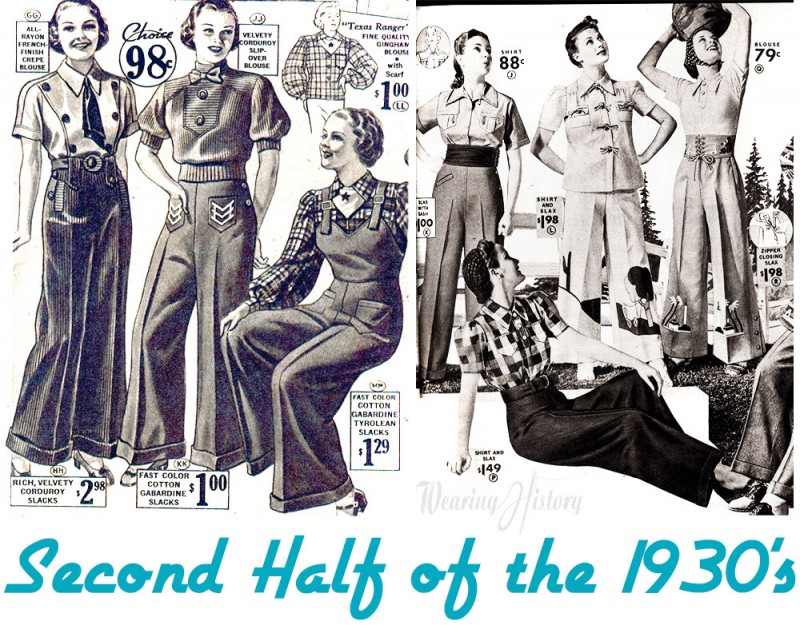 In the second half of the 1930’s, trousers really start going crazy. In 1939 it seemed everyone wanted them, and they were here to stay! There were lounging ones, playing ones, work ones, beach ones, pajamas… and sometimes even dinner outfits. The late 1930’s is playful, and trousers fit in perfectly with that ideal. The image on left is from 1938, and the image on right from 1939. Still notice, they have the very loose fit. Trousers were NOT meant to hug your butt. They really wanted them to fit like a skirt- skimming your hips and rear loosely, then falling to a low crotch, and splitting into a bifurcated garment.
In the second half of the 1930’s, trousers really start going crazy. In 1939 it seemed everyone wanted them, and they were here to stay! There were lounging ones, playing ones, work ones, beach ones, pajamas… and sometimes even dinner outfits. The late 1930’s is playful, and trousers fit in perfectly with that ideal. The image on left is from 1938, and the image on right from 1939. Still notice, they have the very loose fit. Trousers were NOT meant to hug your butt. They really wanted them to fit like a skirt- skimming your hips and rear loosely, then falling to a low crotch, and splitting into a bifurcated garment.
This image is from 1942, and this is what most of us think of when we think of vintage women’s trousers or pants. They’re still for active wear, primarily. You don’t often see them dressed up. In some areas women were shunned if they wore pants. In other areas (including California), they were more widely accepted and sometimes even worn to church- which shocked quite a few (or, so I read, in a 1939 Vogue magazine).
For your WWII impressions, you’ll want a look like these. Are they suitable for every occasion? No, if you want to be accurate. But for war work, home front work, gardening, the beach, or for collegiate looks they fit in great! I wear them all the time in my day to day vintage inspired looks, because I’m honestly not trying to look like I’m out of a time machine- I just want to wear what I like. But if accuracy is your thing, take heed and consider where you live and what your activity is if you want to wear vintage trousers for WWII impressions.
The mid-late 1940’s were all about teen culture. Swing music was here to stay, and fashion followed the teen trends. Here we’ve got three girls wearing teen styles. Women’s trousers for other age groups followed similar lines but were a bit more conservative in tone. Notice we’re getting the narrower legs as we move to the late 1940’s. I’m 33, and I’d totally wear all of these outfits, unashamedly.
Also, take note- it’s the first time we see jeans as we think of them now! Previously, women would have slacks in similar lines to the trousers I pictured made in denim (think my Smooth Sailing trousers), but by the mid 1940’s women had their own version of jeans like the men wore. Previously, most women would wear men’s jeans if they wanted dungarees. If we can’t have it, we’ll wear our brother’s until you give up our own. Worked with trousers, and it worked with jeans :)
Move into the 1950’s and things get slim. Some trousers still followed the lines of the late 1940’s one on the far left, that I posted above, but most started getting really narrow legs. We still don’t have the higher crotch point, like with modern pants (which you’ll notice if you look at the pictures above), but we started moving it a bit upward. It’s the predecessor of the skinny jean- but mixed with the longer crotch length. It’s an… interesting… fit ;)
– Let’s Get Technical –
So, what is “Sanforized”? You may see this on a bunch of old catalog description, and sometimes even printed and woven on old labels. It is NOT a fabric. It is NOT a weave. It’s a PROCESS. It’s basically pre-shrinking your fabric by treating it. Sometimes it’s done before sewing, sometimes it’s done after sewing. This is still a widely used process in the textile industry on natural and cellulose based fibres.
What are “Mannish” or “Man-Tailored” slacks? These terms were used interchangeably throughout the 1930’s and the 1940’s. This just means they were a little more tailored- and usually followed the line of men’s trousers of the time. Women’s trousers, however, almost always fastened up the side instead of the front until you get to the mid 1940s, and even then, it was most common for them to fasten at the side. You do see them with front fastenings in some snapshots of the 1930’s, but these were usually actual men’s trousers, rather than women’s trousers. Girls wore them. Now, boys wear girl’s pants (kidding… kind of). By the late 1950’s, you see front fastening, back fastening, and side fastening trousers.
What are Dungarees? Dungarees and Jeans are basically the same thing. It depends, really, on where you live. Most people think of Dungarees or Jeans as the casual workwear trousers with topstitching details and pockets- the predecessor of today’s jeans or denim. Denim is the weave of cotton that jeans or dungarees are made from. It’s a twill weave and often thicker and sturdier than other twill weaves. But Dungaree is also a fabric! The difference between dungaree and denim is when they are dyed. Dungaree fabric is dyed and then woven, and denim is woven and then dyed.
Now, let’s look at the Rise…
The easiest way to do this is through looking at vintage patterns and their pieces.
Check that out! See the blue line across the middle? That shows where all other rises compare with 1930’s rise (crotch length).
Does that explain why your vintage trousers don’t hug your butt the way you expected?
So, long story short- don’t expect to sew from a vintage pattern, or buy original vintage trousers, and have them fit like modern pants. There’s more to them than the length and leg width!
For a momentary little ad from me… this is why I took SO LONG drafting the Smooth Sailing trousers. This was originally a pattern and now can be pre-ordered as ready to wear clothing well. I was very familiar with the problems of vintage trousers. They just don’t fit in a way that’s comfortable and flattering to most modern women because of what we’re now accustomed to wearing and seeing. Because of this, I drafted the Smooth Sailing trousers to be a mid-point between mid-1930’s and modern fit. They’ve still got a longer crotch line and looser fit from the hip down than modern trousers, but they also don’t ride up your butt like a lot of trousers we see now.
And remember- all vintage trousers and pants were meant to fit at your natural waist. For those who don’t know, that’s where the smallest part of your waist is, near your belly button. When the 60’s came in we started getting low rise, but before that time, things hit higher. Now, we call them “high waist”, but they really just sit at where your natural waist is. We’ve just worn low rise pants for so long that most people have forgotten where the waist technically is located. :)
Want more vintage trouser inspiration? Check out my Pinterest board for 1930s/40s Women in Trousers!
Do you have any questions about vintage trousers or pants? Let me know in the comments!

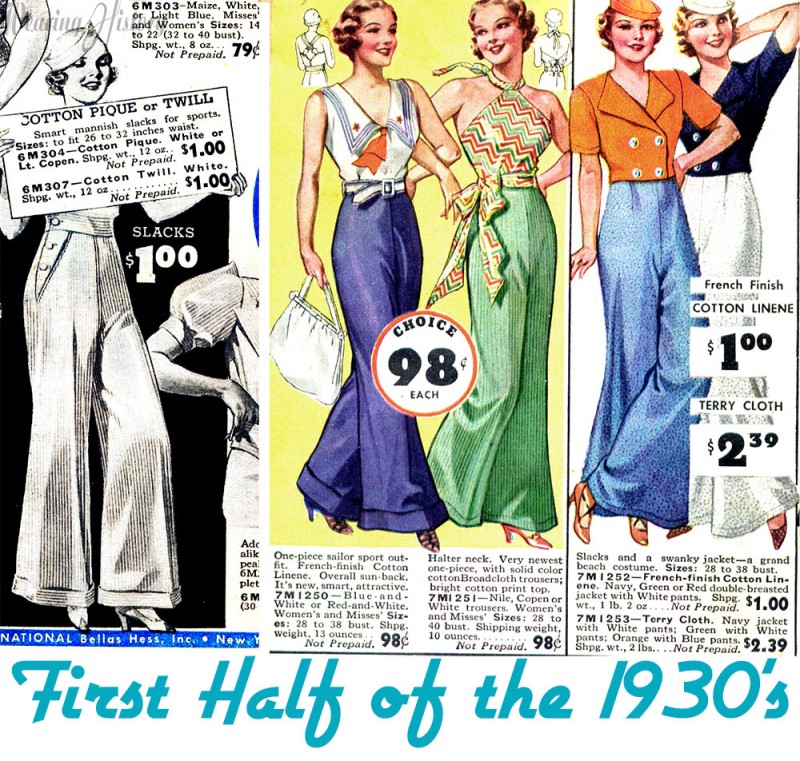
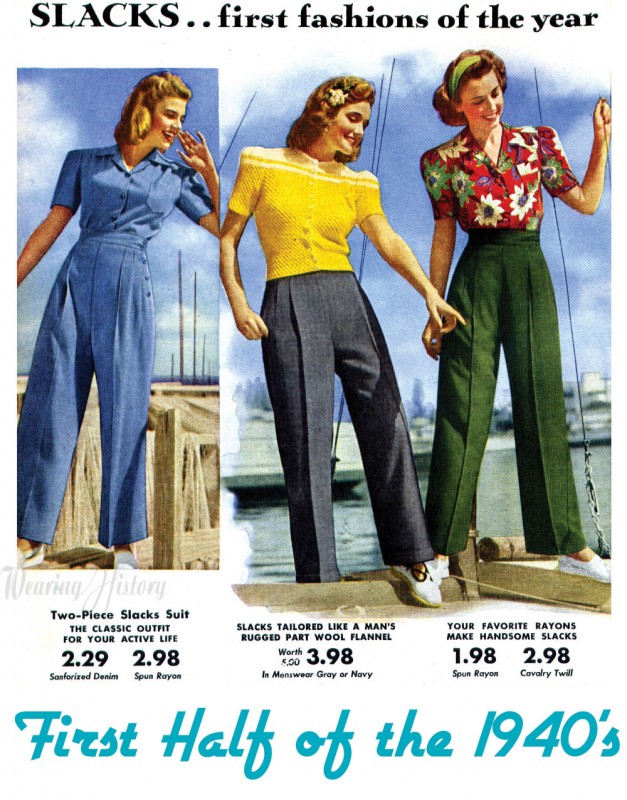
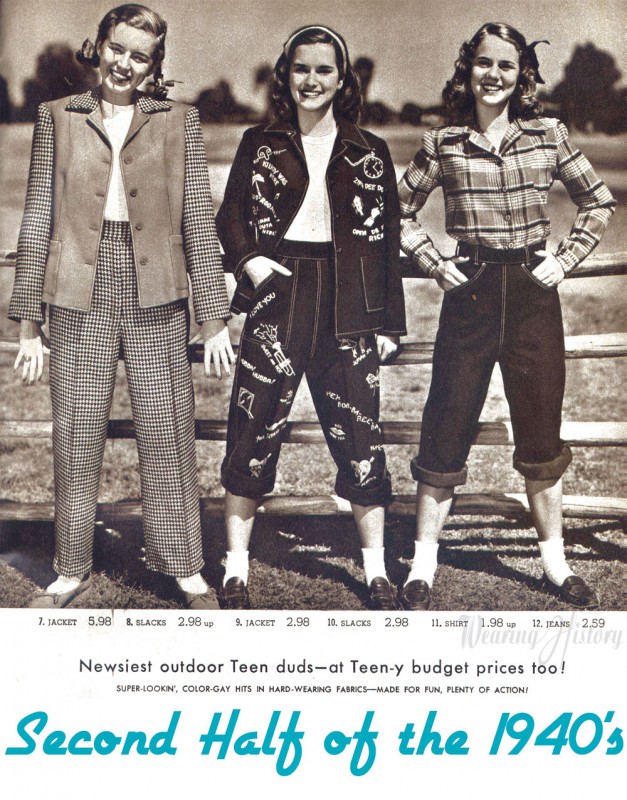
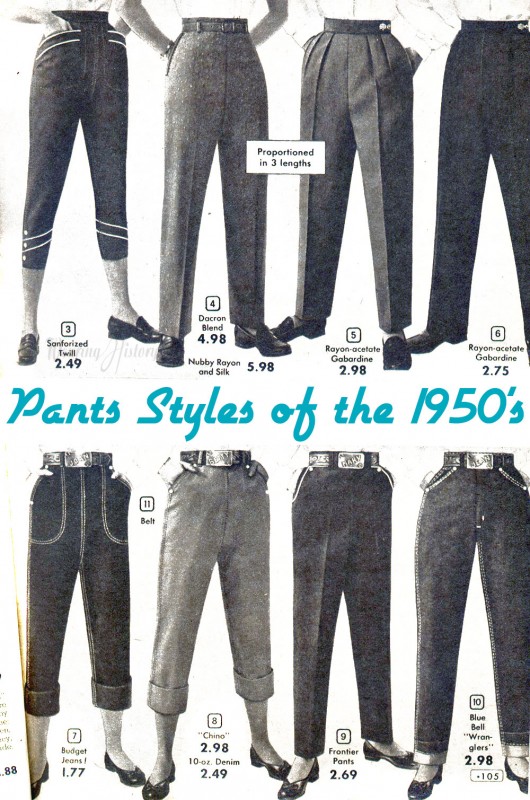
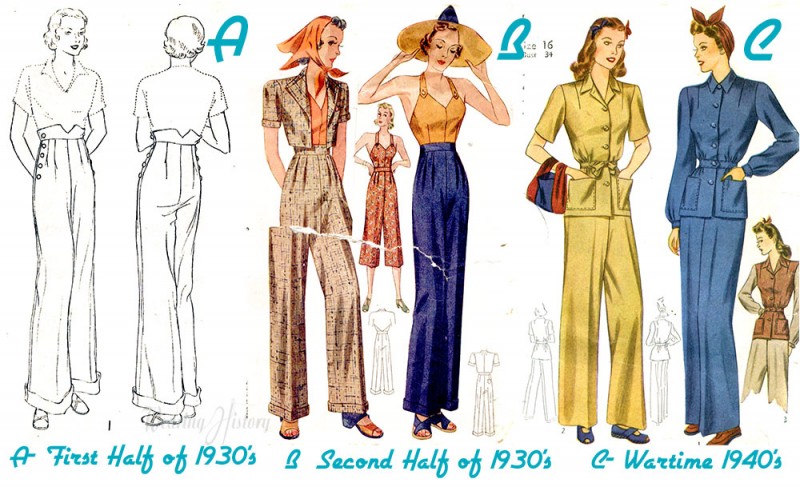
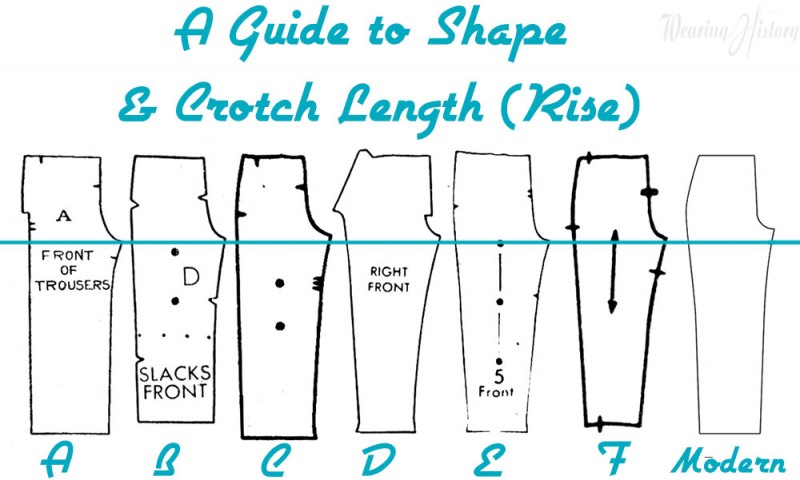
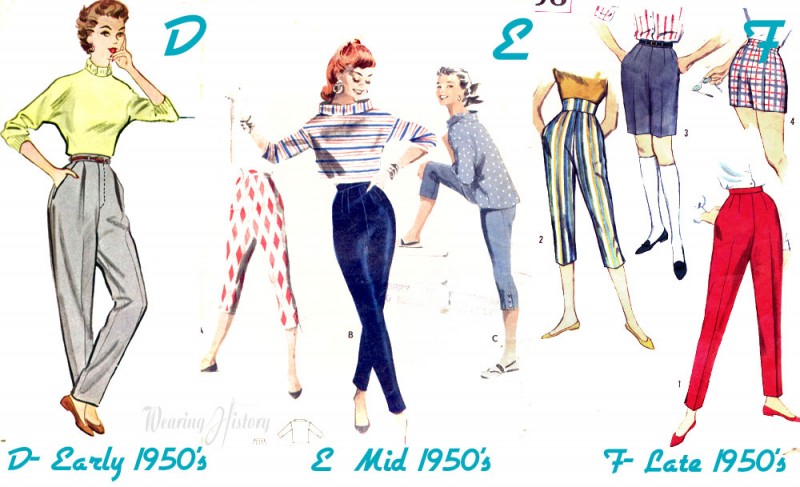
Jeanne Marie
September 11, 2014 at 7:03 pm (10 years ago)Fascinating history. I hope to soon be making a pair of vintage-style wide-leg casual trousers that fits, so your information on the various crotch lengths is very helpful. And, if your Kickstarter goes through (best of luck), I’ll be trying the Smooth Sailing e-pattern!
Bonita Vear (@bjvear)
September 11, 2014 at 7:22 pm (10 years ago)Such a delightfully educational post! I really enjoyed learning about the history of trousers, and now it makes sense as to why even my vintage reproduction trousers still don’t look quite right… Personally, I’d prefer a lower crotch with my trousers and shorts anyway ~ half the time I’m getting a wedgie when sitting down!
Guess I’ll be making my own then. Or buying some Wearing History ones! ;)♡
xox,
bonita of Lavender & Twill
Rozy
September 11, 2014 at 7:35 pm (10 years ago)Wonderful history lesson, thanks for sharing. I don’t like the way modern slacks fit at all, I guess I’ve been a vintage gal all along. By the way, the easiest cure for “muffin top” is to wear slack (pants, trousers) that come all the way up to your natural waist. Why modern women like hip huggers that accentuate the wrong things is beyond me.
Lindy Shopper
September 11, 2014 at 8:04 pm (10 years ago)This explains why I just don’t fit into modern pants and why vintage pants fit so well – I need those extra inches in the crotch length!
Laura
September 11, 2014 at 9:09 pm (10 years ago)How would they fit someone with a pear shape body? Usually they tend not to fit in the waist, if they do at the hips. Thanks!
Pamela Oberman
September 11, 2014 at 11:43 pm (10 years ago)Absolutely love these trousers – reminds me of some great movies with Lauren Bacall and young Kathryn Hepburn swanning around looking glam with elegance and style – in linen crepe and satin
Larissa
September 12, 2014 at 2:42 am (10 years ago)As for wearing trousers: I am getting the feeling, that women in the US could get away with it earlier than in europe. My mother (born in the late 50s) told me that she wasn´t allowed to wear trousers until she was about 15. So even then wearing trousers was frowned upon in smaller towns.
Magpie Stitcher
September 12, 2014 at 7:50 pm (10 years ago)Definitely varied with where you lived/”who you were”! My Mom grew up in a small town in Arkansas in the 1930’s-40’s. (Mining town – her dad was chief engineer.) She wore shorts to play tennis – but a skirt over them when bicycling to & from the tennis court. In college (Stephens Women’s College, in Missouri, then the University of Arkansas just after the War) pants were allowed for riding & sports. Not on the streets, NOT lounging around in the sorority house . . . . she really didn’t like letting me & Little Sister wear jeans, in the ’70’s, probably as a result of this training. Trousers, OK, but jeans were strictly for gardening, playing after school, etc.
How times do change.
Lisette
September 12, 2014 at 5:07 am (10 years ago)I love your diagram on crotch lengths. Would you do a similar one on leg width? So many sewers don’t seem to notice that the “wide leg” 40s styles still taper near the bottom and are disappointed by what they’ve made. I’d love to see how it compares with a 50s leg.
kinseysue (@kinseysue1)
September 12, 2014 at 5:57 am (10 years ago)What a wonderful post. I enjoy reading the history behind the fashions and am always drawn to the 1930s styles. I am not the only who appreciates your research. Thanks for a great blog post.
Brigid Boyer
September 12, 2014 at 9:02 am (10 years ago)This was such an informational post Lauren! I learned a lot, thanks!
Flashback Summer (@EmileighRogers)
September 12, 2014 at 1:07 pm (10 years ago)This. Makes. So. Much. Sense. I’ve worked with vintage pants patterns and had issues. I knew the crotch was lower, but all of this makes it make much more sense, and now I have better expectations of how they’re supposed to fit! (Lying envelope illustrations!)
vintageneedle
September 13, 2014 at 1:54 am (10 years ago)Great insight and now I understand a little better! Thanks for sharing!
Megan
October 13, 2014 at 11:46 am (10 years ago)I am doing a price based comparison, holding inflation constant, on products from the 1950s and today. Where did you get the price of Wrangler jeans in the 1950s graphic from?
Thanks!